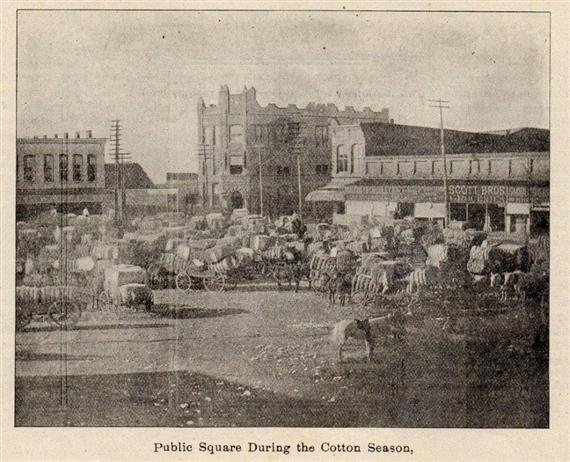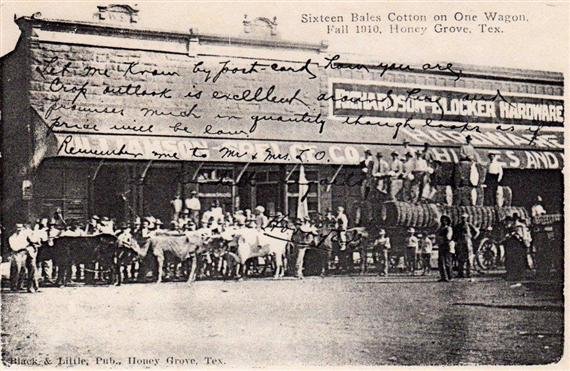Cotton Was King!
For statistics on cotton production, view the Cotton Statistics page.
For more information on cotton gins, click HERE.
For information and photos on cotton weighers and buyers, click HERE.
In the late 1800s and early 1900s the economy of Honey Grove and the surrounding communities was dominated by cotton. According to John Black's Pictorial History, in 1884, 12,989 bales of cotton were produced in Honey Grove. In 1899, 20,000 bales, each sold at $50,00, brought in an estimated $1,000,000; the following year, Honey Grove received 42,500 bales of cotton.
Cotton buyers on the Square linked the cotton farmer to the commercial world, and to the the market economy of Galveston, Liverpool, England, Tokyo and St. Louis. The buyers were important because the profit of a whole year's work was determined, in some cases, by a single transaction. In the fall the farmers ginned their cotton, brought it to town and sold it. The price depended upon the time of year, the quality of cotton and the going price.
The supreme crop was cotton - more important than all the others in terms of cash value to farmers and merchants. The largest cotton broker and shipper in Fannin County, Williamson and Blocker, published a booklet that described the impact of cotton on the community.
"To appreciate the importance of Honey Grove as a great trade mart and distributing point, a person has but to appear on the square during cotton season. People elbow each other as they do through the streets of busy Chicago. The scene presents one connected mass of cotton bales and sometimes the square is practically impassible."
This picture of Honey Grove may be something of an exaggeration but probably not by much. The city was the most important cotton marketing trade center in Fannin County and it was not unusual for the number of bales of cotton shipped from Honey Grove to equal that of all the other bales shipped from all other towns in Fannin County. (The above from John Black's Pictorial History)
Cotton Compress around 1914. Thanks to Murry Hammond for this photo.
The following text from a pamphlet, The Golden Age: When Cotton Was King in the Red River Valley of Northeast Texas, 1890-1930.
Cotton was planted in Northeast Texas in only small amounts until steam powered gins were erected in the late 1800's and merchants opened businesses where cotton could be sold or exchanged for goods. As a cash crop, it reached its peak in the virgin soil of the Valley during the first decades of the 20th century, before the appearance of the boll weevil, Johnson grass, and the depression of the 1920's and 30's. The uncertainty of the cotton crop production and the price to be received has made the cotton crop largely a gamble.
Many factors have influences the decline in cotton production in the Red River Valley over the past half century, chiefly the lack of labor, the high cost of equipment and labor, expensive fertilizers and insecticides, and the harsh labor requirements to cultivate and harvest cotton.
Photo of the Farmers Gin from the February 4, 1994 Honey Grove Signal-Citizen







